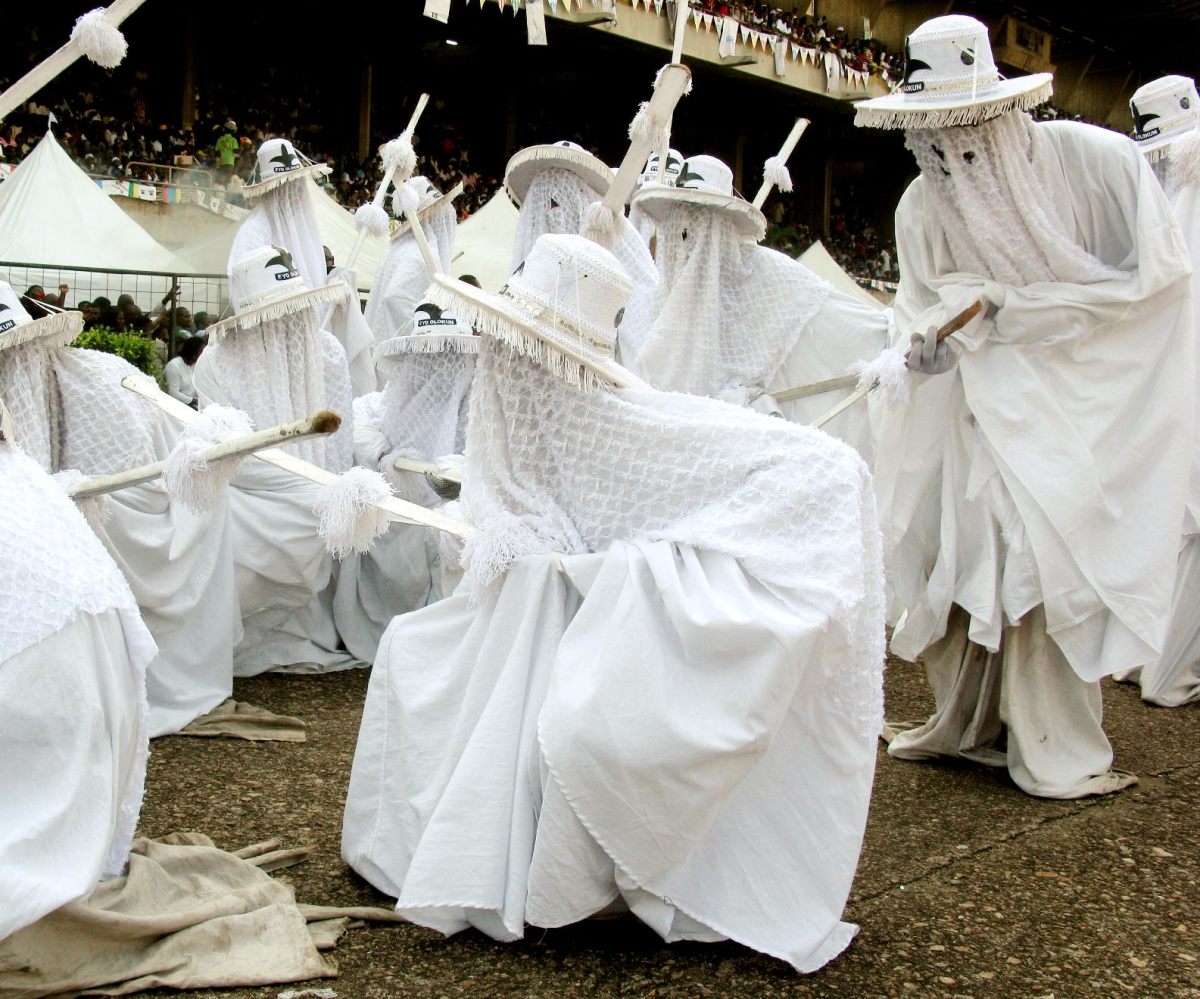The Eyo Festival, also known as the Adamu Orisha Play, is a Yoruba festivity held only in Lagos, Nigeria. It is being promoted as a tourist attraction by Lagosians due to its history and customary performance on Lagos Island.
The term “Eyo” is also used to characterize the festival’s masquerades or dressed-up dancers. The inner workings of Lagos’s hidden groups are where this celebration began. The Eyo festival was traditionally celebrated to welcome a new king as well as to accompany the soul of a departed Lagos King or Chief.
According to legend, the Eyo Masquerade was introduced to Lagos Island around 1750 by two unnamed persons from the communities of Ibefun and Ijebu in present-day Ogun State.
They were successful in incorporating it into the burial rites of passage for the time’s outgoing Oba, Oba Ado, who is supposed to have married one of their cousins, Olugbani. This was as a result of their persuasive appeal.
Eyo Orisa Oniko was ranked second to Eyo Orisa Adimu, but during his reign, Oba Adele ordered Okanlabato to take his place, and it has remained that way ever since.
According to research, Eyo Okanlaba only has a “Laba” (symbolic bag) that belongs to the current Oba and no Orisa.
As a result, Okanlaba’s position in the Orisa group has remained unaltered and will remain unchanged indefinitely.
According to legend, each “Orisa of Eyo” is assigned traditional responsibilities that must be carried out in line with the directives of “Orisa Adimu,” the Supreme Head of all Orisas, including the Eyo Onilaba, also known as the Eyo Oba or Eyo Alakete Pupa.
This order will likewise be carried out by the “police” of the Orisa Adimu regime in Laba. As a result, these orisas are in charge of enforcing severe discipline among the Eyo groups.
Furthermore, these Orisas are tasked with ensuring that the Eyo gang abides by the rules of the Adamu Orisa Play.
As a result, they make certain that they follow Awe Adimu’s directions and communicate with him frequently during the preparation process and on the day of the Adamu Orisa Play.
People believe that the play is an example of a traditional African celebration that precedes Brazil’s modern carnival.
While certain Orisas, such as Orisa Ogunran and Orisa Elegbaopopo, were transported from Benin to Lagos by Chief Olorogunagan Asagbemi during the reign of Oba Ado of Lagos 350 years ago, some historians think Eyo was brought from Ibefun to guard the deities.
According to some sources, Eyo started in Iperu, which is considered the source and cradle of Eyo in Nigeria and even the world. According to the study, alongside the four Iperu royal houses, the “Iga éyo Pakeriké” is the main source of Eyo in Iperu.
Iperu’s Iga Eyo are further classified into five types: Iga Eyo Akesan, Iga Pakerike (represented by the red cap of éyo), Iga Agbonmagbe (represented by the blue cap of éyo), Iga éyo Odoru, Iga éyo Mogusen/Amororoo, and Iga éyo Fibigbuwa.
However, history has revealed that Eyo was brought to Lagos to celebrate the in-law, and its first parade was held in Lagos on February 20, 1854, to honour the life of Oba Akintoye, and it has since become the state’s custom.
Significance of this Festival

The Eyo Festival is celebrated for various reasons, each carrying a significant cultural and spiritual meaning:
- Honouring the Deceased: At its core, the festival serves as a way to pay tribute to the departed souls of prominent Lagosians. The Eyo Masquerades are believed to embody the spirits of these ancestors, and the festival provides an opportunity for their remembrance and celebration.
- Cultural Preservation: The Eyo Festival is a testament to the rich Yoruba culture and heritage. It showcases traditional clothing, music, dance, and customs that have been passed down through generations. In a rapidly modernizing world, the festival plays a crucial role in preserving and promoting these cultural elements.
- Community Unity: The Eyo festival fosters a sense of unity and togetherness among the people of Lagos. It brings communities together, regardless of social or economic status, to participate in the festivities and celebrate their shared heritage.
- Tourism and Economic Impact: The Eyo Festival has also become a significant tourist attraction, drawing visitors from around the world. This influx of tourists has a positive impact on the local economy, boosting businesses and providing employment opportunities.
Modern Eyo Festival
The bulk of the Yorubas’ original believers in Christianity and Islam have abandoned their traditional traditions.
Whatever the case, the traditional celebrations are still extensively recognized as tourist attractions that generate significant revenue for the local authorities and small businesses in the vicinity of the Eyo festival’s venue on Lagos Island.
The Eyo festival was held in 2000 to celebrate the death of Justice G.B.A. Coker, a Lagos high chief and the Olori Adimu of the Adimu Eyo cultural masquerade.
On November 26, 2011, another event was conducted to honour the life of Lagos aristocrat Prince Yesufu Abiodun Oniru. And on May 20, 2017, which was the last Eyo celebration organized to commemorate Lagos state’s 50th anniversary, to honor the late Oba of Ikate Kingdom Oba Yekini Adeniyi Elegushi Kunsela 11.
Motorcycles or taxis, bicycles, sandals, Suku (hairstyle), smoking, female with head tie, male with any form of cap, and wearing the Eyo costume overnight or crossing a river or lagoon are prohibited during the Eyo festival.
